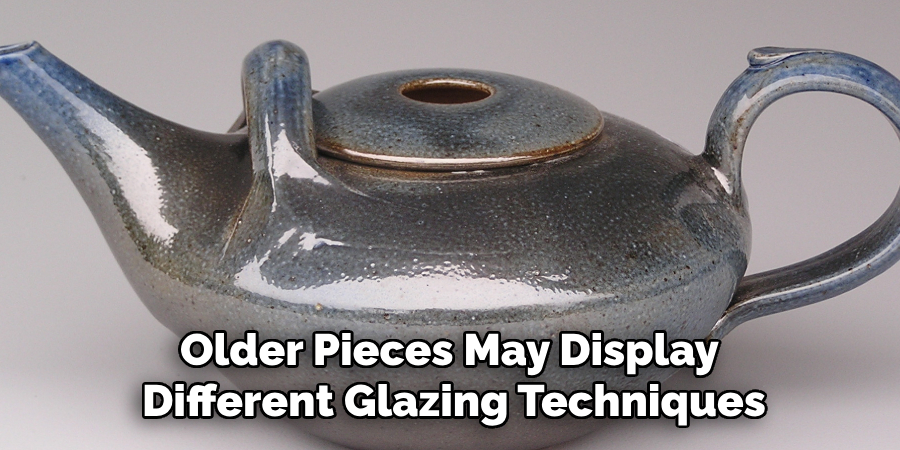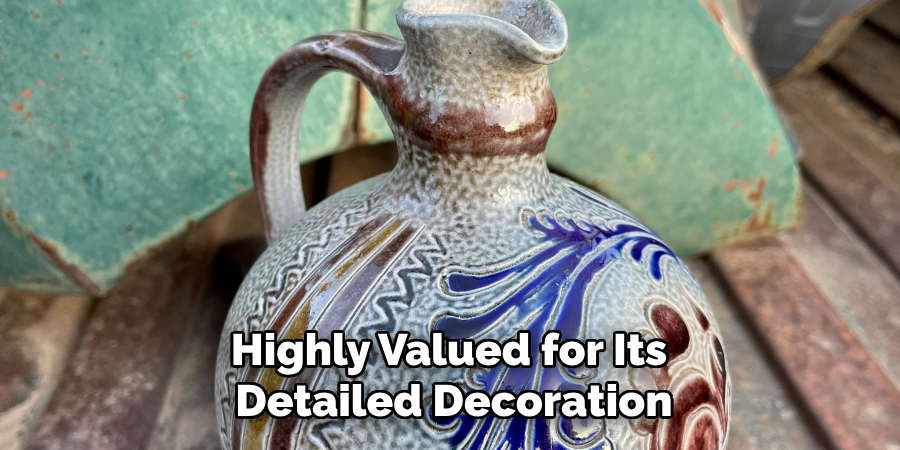Salt-glazed pottery holds a significant place in the history of ceramics and is cherished by collectors, historians, and ceramics enthusiasts alike. Originating in the 15th century, this type of pottery is renowned for its distinctive glossy and textured surface, created through a unique glazing process. Salt is introduced into the kiln during firing, causing a chemical reaction that forms a hard, glass-like finish on the pottery.

This results in a distinctive “orange peel” texture, often accompanied by brilliant shades ranging from clear to brown. For those wondering how to identify salt-glazed pottery, these features are invaluable clues. Recognizing authentic salt-glazed pieces is important for appreciating their artistry and understanding their historical context and value. The allure of salt-glazed pottery lies in its combination of elegance and durability, making it a mainstay in both historical collections and modern interpretations.
History of Salt-Glazed Pottery
Salt glazing originated in Germany during the 14th century, marking a revolutionary approach in ceramics. Initially crafted in the Rhineland area, its unique method swiftly garnered popularity across Europe, making its way to England by the 17th century. Potters further developed the technique, contributing to its widespread use and adaptation worldwide. Traditionally, salt-glazed pottery served multiple utilitarian purposes, seen in durable items like stoneware jugs, storage jars, and even decorative pieces, prized for their charming rustic aesthetic.
Over time, the salt glazing process evolved significantly, with potters experimenting with different materials and firing techniques. This evolution led to diverse styles and finishes, reflecting cultural nuances across different regions. These variations in production methods enhanced the artistic expression possible within this technique, ensuring its continued relevance and appeal in modern ceramics.
How to Identify Salt-Glazed Pottery: Visual Characteristics
Surface Texture
One of the defining features of salt-glazed pottery is its distinctive surface texture, often referred to as an “orange-peel” or bumpy finish. This unique texture results from a fascinating chemical reaction that occurs during the firing process. When salt is introduced into the kiln at high temperatures, it vaporizes and interacts with the silica content within the clay body. This reaction forms a sodium-silicate glaze, which creates the characteristic rough, pebbly surface. Collectors and enthusiasts often look for this texture as a key indicator of authentic salt-glazed pottery.

Glaze Color
Salt-glazed pottery is renowned for its earthy and natural color palette. Typical colors include various shades of brown, tan, gray, and occasionally, hues of blue. These colors result from the sodium-silicate glaze and depend heavily on the type of clay body used and specific firing conditions within the kiln. Local mineral content present in the clay can influence the color outcome, leading to subtle variations in tone and depth. This diversity in coloration adds to the appeal and uniqueness of each piece.
Pottery Form
Salt-glazed pottery often features a common array of forms, with functional items such as jars, jugs, plates, and bowls being particularly prevalent. The robust nature of salt-glazed stoneware makes these forms ideal for both storage and practical purposes. Stylistically, these pieces feature characteristic elements such as handles or decorations. These features can help identify items that have undergone the distinct salt glazing process.
Decoration Techniques
Salt-glazed pottery often showcases a variety of traditional decoration techniques that enhance its timeless appeal. Common methods include incising, where designs are carved into the clay; slip trailing, where a liquid clay slip is applied for textured embellishments; and stamping, which involves pressing designs into the clay surface. While not all salt-glazed pottery is decorated, these techniques often accompany this type of pottery, allowing for artistic expressions that vary between simple to elaborate designs. These techniques add an additional layer of artistic value, making salt-glazed pieces highly sought after by collectors and appreciators of ceramics.

How to Identify Salt-Glazed Pottery: Examining the Base and Markings
Foot Rim
When examining salt-glazed pottery, the foot rim offers valuable insights into its authenticity. Salt-glazed pieces typically feature a distinctive, unglazed foot rim, as the base of the pottery is left without glaze where it rests during firing. This results in a visible rough texture, an important identifying feature. Collectors should inspect the foot rim for this texture, contrasting with the otherwise glossy pottery surface.
Maker’s Marks
Maker’s marks, stamps, or signatures present on the base of salt-glazed pottery are significant for identifying its origin and verifying authenticity. Notable potteries, especially those hailing from England, often have specific marks that are well-documented and sought after by collectors. These marks provide information about the pottery’s maker and add historical context and value, as they link the piece to a particular region and period in ceramics’ history.
Age Indicators
Assessing the age of salt-glazed pottery involves observing various characteristics such as the style of markings, foot shape, and signs of wear. Older pieces may display different glazing techniques compared to contemporary examples. Wear and patina on the foot rim, and base can suggest significant age, while the style of maker’s marks can indicate specific time periods or potters. Identifying whether the pottery has evolved techniques or tools can also aid in dating the piece, enhancing its historical and collectible value.

Conducting a Water Test
Step 1: Prepare the Test
To perform a water test on salt-glazed pottery, ensure the piece is clean. Use a clean, dry cloth to gently wipe the surface of the pottery. Removing dust or debris is essential to ensure accurate results during the test.
Step 2: Apply Water
Once the pottery is clean, carefully drip a few drops of water onto its surface. Observe how the water interacts with the glaze. Genuine salt-glazed pottery’s surface is slightly porous, and it is expected that the water will be absorbed to some degree.
Step 3: Analyze Results
Analyze the behavior of the water on the pottery. If the water beads up on the surface, this could indicate that the piece isn’t true salt-glazed pottery or may be coated with another type of glaze. On the other hand, slight water absorption suggests authentic salt glazing due to its characteristic porous nature. However, complete absorption indicates that the clay may be more porous than typical salt-glazed surfaces, possibly pointing to variations in the clay composition or firing technique.
Identifying Salt-Glazed Pottery by Region
British Pottery
Salt-glazed pottery from England is particularly notable for its origin in the West Midlands and Staffordshire regions. These areas were pioneers of the salt glazing technique, contributing significantly to its popularity and evolution. The pottery crafted here is distinguished by a traditional aesthetic, often featuring fine detailing and a balance of form and function.
Renowned potters, such as Josiah Wedgwood and the Bartlam family, were instrumental in advancing the art of salt glazing. Wedgwood, known for his innovative approaches and exquisite craftsmanship, helped set a standard of quality that continued to influence potters throughout Britain. Meanwhile, the Bartlam family contributed to the expansion of salt-glaze aesthetics, making their mark on both European and American pottery traditions.
American Salt-Glazed Pottery
In the United States, the technique of salt glazing gained momentum during the 18th and 19th centuries. It was particularly embraced in Pennsylvania and the American South, where potters adapted the method to local tastes and traditions. These areas developed distinctive styles characterized by practical designs, often used for storage or daily utility.
The German immigrant communities in Pennsylvania, particularly, became well-known for their stoneware, blending European techniques with American innovation. Southern salt-glazed pottery also stood out for its robust forms and utilitarian elegance, reflecting the region’s cultural landscape during this period.
German Pottery
German salt-glazed pottery, highly valued for its detailed decoration and diverse color variations, has a rich heritage rooted in historical centers like Westerwald. This region is famous for its intricate cobalt blue designs against a contrasting grey body, reflecting both functional artistry and decorative appeal.

German potters excelled in using molds and incised designs, creating pieces that were as ornate as they were functional. The meticulous craftsmanship and bold decorative elements found in Westerwald pottery embody a tradition that has influenced salt glazing worldwide, making it a focal point of study for collectors and historians alike.
Conclusion
Salt-glazed pottery is renowned for its distinctive glossy surface, often accompanied by maker’s marks that reveal its origin and authenticity. Key characteristics, such as the unglazed foot rim and slight porosity verified through a water test, contribute to identifying genuine pieces. Recognizing the diverse regional styles, from Britain’s traditional designs to America’s utilitarian forms and Germany’s ornate decorations, enriches one’s understanding and appreciation of this craft.
The process of how to identify salt-glazed pottery involves studying these nuances, which reflect a tapestry of historical and artistic significance. We encourage readers to delve into this world by visiting local pottery shops, galleries, and auctions, where they can discover authentic pieces. By exploring these venues and sharing experiences, enthusiasts can foster a community dedicated to preserving and celebrating salt-glazed pottery’s rich legacy, ensuring that this traditional art form continues to inspire future generations.
Check it Out to Use Underglaze
Specialization:
- Master of wheel-throwing, hand-building, and advanced glazing techniques
- Focus on creating both functional pottery and decorative art pieces
Recognition:
- Celebrated by collectors and art enthusiasts for creating one-of-a-kind pieces that blend artistry with functionality
- Participates in local and national exhibitions, earning accolades for his innovative designs and craftsmanship
Passion:
- Deeply committed to exploring and pushing the boundaries of ceramic artistry
- Continuously experiments with new materials, firing techniques, and artistic concepts to evolve his craft
Personal Philosophy:
- Believes in the transformative power of art, aiming to evoke emotions and connections through his ceramic creations
- Advocates for sustainability in ceramics, using eco-friendly materials and practices whenever possible


